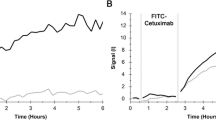Abstract
Protein–protein interaction (PPI) analysis is very important for elucidating the functions of proteins because many proteins execute their functions in living cells by interacting with one another. In PPI analysis, methods using the sensor chips are widely employed to obtain quantitative data. However, these methods require that the target proteins be immobilized on the sensor chips, and the immobilization processes can affect the binding of the target proteins to their binding partners. In the present work, we propose a PPI analysis system in which the surface of the living cells is utilized as a sensing platform. In our approach, the target protein is displayed on the cell surface by expressing it as a fusion protein with a membrane protein, and the PPI analysis is then conducted by applying its binding partner labeled with a fluorescent dye to the cell surface. We have constructed a model of this binding analysis system using the interaction between biotin protein ligase (BPL) and biotin carboxyl carrier protein (BCCP), where BCCP was displayed on the cell surface and BPL labeled with fluorescein was applied to the cell surface. Here, a red fluorescent protein, mApple, was attached to the C-terminus of the fusion protein of BCCP with a membrane protein. We evaluated the binding level of the labeled BPL by using the intensity ratios of fluorescence from fluorescein to that from mApple. We found that the binding level of the labeled BPL was stably evaluated at least across 60 min observation period and estimated the binding dissociation constant between BPL and BCCP by equilibrium analysis to be 0.33 ± 0.05 μM.
Graphical abstract






Similar content being viewed by others
Data availability
The datasets generated during the current study are available from the corresponding author on reasonable request.
References
T. Berggård, S. Linse, P. James, Proteomics 7, 2833 (2007). https://doi.org/10.1002/pmic.200700131
V. Srinivasa Rao, K. Srinivas, G.N. Sujini, G.N. Sunand Kumar, Int. J. Proteomics 2014, 147648 (2014). https://doi.org/10.1155/2014/147648
M. Zhou, Q. Li, R. Wang, ChemMedChem 11, 738 (2016). https://doi.org/10.1002/cmdc.201500495
K. Titeca, I. Lemmens, J. Tavernier, S. Eyckerman, Mass Spectrom. Rev. 38, 79 (2019). https://doi.org/10.1002/mas.21574
H. Elhabashy, F. Merino, V. Alva, O. Kohlbacher, A.N. Lupas, Structure 30, 462 (2022). https://doi.org/10.1016/j.str.2022.02.004
Y.Y. Wang, W. Li, B.C. Ye, X.B. Bi, Chem. Asian J. 18, e202300226 (2023). https://doi.org/10.1002/asia.202300226
B. Suter, S. Kittanakom, I. Stagljar, Curr. Opin. Biotechnol. 19, 316 (2008). https://doi.org/10.1016/j.copbio.2008.06.005
B. Stynen, H. Tournu, J. Tavernier, P. Van Dijck, Microbiol Mol Biol Rev. Mol. Biol. Rev. 76, 331 (2012). https://doi.org/10.1128/MMBR.05021-11
G. MacBeath, S.L. Schreiber, Science 289, 1760 (2000). https://doi.org/10.1126/science.289.5485.1760
Y. Lee, E.K. Lee, Y.W. Cho, T. Matsui, I.C. Kang, T.S. Kim, M.H. Han, Proteomics 3, 2289 (2003). https://doi.org/10.1002/pmic.200300541
T.Y. Low, S.E. Syafruddin, M.A. Mohtar, A. Vellaichamy, N.S.A. Rahman, Y.F. Pung, C.S.H. Tan, Cell. Mol. Life Sci. 78, 5325 (2021). https://doi.org/10.1007/s00018-021-03856-0
A.K. Kenworthy, Methods 24, 289 (2001). https://doi.org/10.1006/meth.2001.1189
H. Kobayashi, L.P. Picard, A.M. Schönegge, M. Bouvier, Nat. Protoc. 14, 1084 (2019). https://doi.org/10.1038/s41596-019-0129-7
E. Blaszczak, N. Lazarewicz, A. Sudevan, R. Wysocki, G. Rabut, Biochem. Soc. Trans. 49, 1337 (2021). https://doi.org/10.1042/BST20201058
D. Capelli, V. Scognamiglio, R. Montanari, TrAC. Trends Anal. Chem. 163, 117079 (2023). https://doi.org/10.1016/j.trac.2023.117079
P.J. Jandasa, K. Prabakaran, J. Luoa, D. Holladay, Sens. Actuators A Phys. 331, 113020 (2021). https://doi.org/10.1016/j.sna.2021.113020
P. Zhang, X. Zhou, J. Jiang, J. Kolay, R. Wang, G. Ma, Z. Wan, S. Wang, Angew. Chem. Int. Ed. Engl.. Chem. Int. Ed. Engl. 61, e202209469 (2021). https://doi.org/10.1002/anie.202209469
Y. Guan, X. Shan, F. Zhang, S. Wang, H.Y. Chen, N. Tao, Sci. Adv. 1, e1500633 (2015). https://doi.org/10.1126/sciadv.1500633
Y.Q. Li, S. Sueda, H. Kondo, Y. Kawarabayasi, FEBS Lett. 580, 1536 (2006). https://doi.org/10.1016/j.febslet.2006.01.083
S. Sueda, Y.Q. Li, H. Kondo, Y. Kawarabayasi, Biochem. Biophys. Res. Commun. 344, 155 (2006). https://doi.org/10.1016/j.bbrc.2006.03.118
B. Bagautdinov, Y. Matsuura, S. Bagautdinova, N. Kunishima, J. Biol. Chem. 283, 14739 (2008). https://doi.org/10.1074/jbc.M709116200
S. Sueda, H. Tanaka, M. Yamagishi, Anal. Biochem. 393, 189 (2009). https://doi.org/10.1016/j.ab.2009.06.027
G.J. Kremers, K.L. Hazelwood, C.S. Murphy, M.W. Davidson, D.W. Piston, Nat. Methods 6, 355 (2009). https://doi.org/10.1038/nmeth.1319
S. Sueda, S. Yoneda, H. Hayashi, ChemBioChem 12, 1367 (2011). https://doi.org/10.1002/cbic.201000738
T. Taniyama, N. Tsuda, S. Sueda, ACS Chem. Biol. 13, 1463 (2018). https://doi.org/10.1021/acschembio.8b00219
S. Jitrapakdee, J.C. Wallace, Biochem. J. 340, 1 (1999). https://doi.org/10.1042/bj3400001
A. Chapman-Smith, J.E. Cronan Jr., Biomol. Eng. 16, 119 (1999). https://doi.org/10.1016/s1050-3862(99)00046-7
T. Wu, M. Kumar, J. Zhang, S. Zhao, M. Drobizhev, M. McCollum, C.T. Anderson, Y. Wang, A. Pokorny, X. Tian, Y. Zhang, T. Tzounopoulos, H.W. Ai, Sci. Adv. 9, eadd2058 (2023). https://doi.org/10.1126/sciadv.add2058
Acknowledgements
This work was supported by JSPS KAKENHI Grant Number 21K05130.
Author information
Authors and Affiliations
Corresponding author
Ethics declarations
Conflict of interest
The authors declare no conflict of interest regarding the content of this article.
Supplementary Information
Below is the link to the electronic supplementary material.
Rights and permissions
Springer Nature or its licensor (e.g. a society or other partner) holds exclusive rights to this article under a publishing agreement with the author(s) or other rightsholder(s); author self-archiving of the accepted manuscript version of this article is solely governed by the terms of such publishing agreement and applicable law.
About this article
Cite this article
Hirano, K., Sueda, S. A fluorescence-based binding assay for proteins using the cell surface as a sensing platform. ANAL. SCI. 40, 563–571 (2024). https://doi.org/10.1007/s44211-023-00476-5
Received:
Accepted:
Published:
Issue Date:
DOI: https://doi.org/10.1007/s44211-023-00476-5




